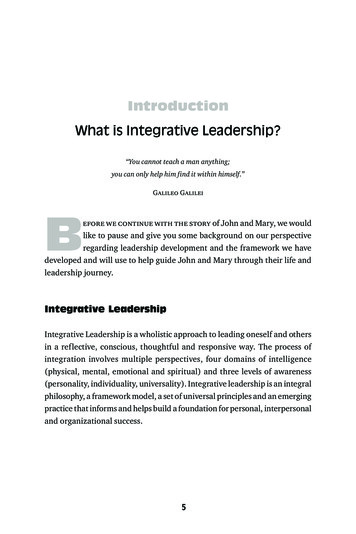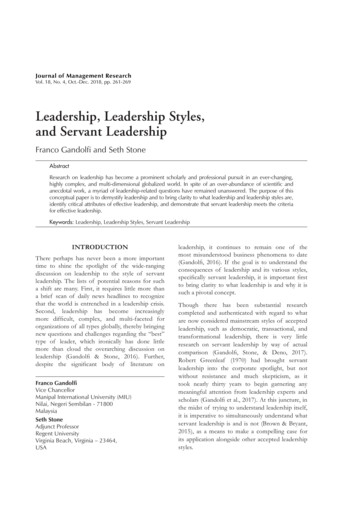
Transcription
Leadershipand LeadershipDevelopmentin Health Care:The Evidence Base
ContentsLeadership and Leadership Development in Health Care:The Evidence Base1Acknowledgements1Summary2Leadership for cultures of high quality care5Review structure7Leadership theory and research7Leadership theory and research in health care10Leadership, culture and climate in health care14Leader and leadership development17Conclusions23References24Appendix: Review methods31
Leadership and Leadership Development inHealth Care: The Evidence BaseProfessor Michael WestThe King’s Fund and Lancaster University Management SchoolKirsten Armit, Dr Lola LoewenthalFaculty of Medical Leadership and Management, LondonDr Regina EckertThe Center for Creative Leadership, BelgiumThomas WestAston Business School, Aston UniversityAllan LeeManchester Business SchoolAcknowledgementsThe authors would like to thank the following people for their support and involvement in this work:Deena Maggs, Beatrice Brooke and Kirsty Morrison (The King’s Fund)Anna Topakas (University of Sheffield)Wouter Keijser (TeamSHOPP Netherlands)Elise Anderson (Center for Creative Leadership)Peter Lees (Faculty of Medical Leadership and Management)1
SummaryThe key challenge facing all NHS organisations is to nurture cultures that ensure the delivery of continuouslyimproving high quality, safe and compassionate healthcare. Leadership is the most influential factorin shaping organisational culture and so ensuring the necessary leadership behaviours, strategies andqualities are developed is fundamental. What do we really know about leadership of health services?The Faculty of Medical Leadership and Management (FMLM), The King’s Fund and the Center for CreativeLeadership (CCL) share a commitment to evidence-based approaches to developing leadership andcollectively initiated a review of the evidence by a team including clinicians, managers, psychologists,practitioners and project managers. This document summarises the evidence emerging from that review.The summary describes key messages from the review in relation to leadership at different levels ofanalysis: it includes a description of the leadership task and the most effective leadership behaviours atindividual, team, board and national levels.The leadership taskThe leadership task is to ensure direction, alignment and commitment within teams and organisations(Drath, McCauley, Palus, Van Velsor, O’Connor, McGuire, 2008). Direction ensures agreement and prideamong people in relation to what the organisation is trying to achieve, consistent with vision, valuesand strategy. Alignment refers to effective coordination and integration of the work. Commitmentis manifested by everyone in the organisation taking responsibility and making it a personal priorityto ensure the success of the organisation as a whole, rather than focusing only on their individual orimmediate team’s success in isolation.Individual leadership in health servicesEffective leaders in health services emphasise continually that safe, high quality, compassionate careis the top priority. They ensure that the voice of patients is consistently heard at every level; patientexperience, concerns, needs and feedback (positive and negative) are consistently attended to.They offer supportive, available, empathic, fair, respectful, compassionate and empowering leadership.They promote participation and involvement as their core leadership strategy. They ensure the staff ‘voice’is encouraged, heard and acted on across the organisation and provide practical support for staff toinnovate within safe boundaries.They ensure everyone is clear about what they are required to do and give helpful, positive feedback onperformance, including appreciation. They insist on transparency in relation to errors, serious incidents,complaints and problems and they regard mistakes as opportunities for learning. They act effectively to dealwith poor performance and proactively address aggressive, inappropriate and unacceptable behavioursdisplayed by staff or patients/carers.They promote continuous development of the knowledge, skills and abilities of staff in order to improvequality of patient care, safety, compassion and the patient experience. They consistently encourage, motivateand reward innovation and introduce new and improved ways of working.Team leadershipTeam leaders create a strong sense of team identity by ensuring: the team has articulated a clear andinspiring vision of the team’s work; there is clarity about the team’s membership; team members agreefive or six clear, challenging, measureable team objectives; there is strong commitment to collaborativecross-team and cross-boundary working.2
Team leaders ensure: there is shared leadership in teams and members are fully involved in appropriatedecision making; responsibility for decisions is delegated to members appropriately; and there areconstructive debates about how to provide and improve high quality patient care.They also ensure the team regularly takes time out from its work to review its performance and how itcan be improved, and there is a team climate of positivity, characterised by optimism, team efficacy,mutual supportiveness and good humour.Leadership of organisationsBoard leadership is most effective when boards enact the vision and values of their organisations throughwhat they attend to, monitor, reprove or reward; when they listen to patient voices as the most importantsources of feedback on organisational performance; and when they listen to staff voices to discover howthey can best support and enable staff to provide high quality patient care.Effective boards ensure a strategy is implemented for nurturing a positive culture; sense problems beforethey happen and improve organisational functioning; promote staff participation and proactivity; enableand encourage responsible innovation by staff; and engage external stakeholders effectively to developcooperative relationships across boundaries.National level leadershipNational level leadership plays a major role in influencing the cultures of NHS organisations. Numerousreports have called for the various bodies that provide national leadership to develop a single integratedapproach, characterised by a consistency of vision, values, processes and demands. The approach of nationalleadership bodies is most effective when it is supportive, developmental, appreciative and sustained;when health service organisations are seen as partners in developing health services; and when healthservice organisations are supported and enabled to deliver ever improving high quality patient care. Thecultures of these national organisations should be collective models of leadership and compassion for theentire service.Leader and leadership developmentOverall, there is little robust evidence for the effectiveness of specific leadership developmentprogrammes. Undoubtedly some programmes work for some people some of the time, but evaluatingtheir effectiveness empirically is challenging and demonstrating positive effects on patient outcomes isdifficult. The interventions are diverse, participants face different work challenges and those providingthe programmes have varying experience, knowledge and skill. More evidence-based approaches toleadership development in health care are needed to ensure a return on the huge investments made.Experience in leadership is demonstrably valuable in enabling leaders to develop their skills especiallywhen they have appropriate guidance and support.In comparison with the focus on leader development, leadership development – the development ofthe capacity of groups and organisations for leadership as a shared and collective process – is far lesswell explored and researched. However, much of the available evidence, particularly in the NHS,highlights the importance of collective leadership and advocates a balance between individual skillenhancement and organisational capacity building. A collective leadership culture is characterised byshared leadership where there is still a formal hierarchy but the ebb and flow of power is situationallydependent on who has the expertise at each moment. Research evidence suggests this is valuable,particularly at team level.3
There is also a clear, compelling and urgent need for leadership cooperation across boundaries (anotherkey element of collective leadership) within and across organisations. Health care has to be deliveredincreasingly by an interdependent network of organisations. This requires that leaders work together,spanning organisational boundaries both within and between organisations, prioritising overall patientcare rather than the success of their component of it. That means leaders working collectively and buildinga cooperative, integrative leadership culture – in effect collective leadership at the system level.The current emphasis in the NHS on empowering clinicians and other front-line staff in terms of theirdecision-making competencies, also emphasises implicitly the need for collective leadership that includesa broader practice of leadership by clinicians and other front-line staff, rather than by designatedmanagers alone. Such collective leadership is best achieved by a developmental focus on the collective,rather than on individual leaders alone. However, traditional leader-centric development programmeswith tenuous links to organisational outcomes have continued to dominate.The implication of this new understanding of leadership is that our approach to leader and leadershipdevelopment is distorted by a preoccupation with individual leader development (important thoughit is), often provided by external providers in remote locations. Developing collective leadership foran organisation depends crucially on context and is likely to be best done ‘in place’, highlighting theimportant contribution of organisation development and not just leader development.The leadership of organisations needs to be consistent in terms of leadership styles and behaviours;in developing shared leadership across the organisation; in embodying the vision and values of theorganisation; in ensuring shared and consistent approaches to performance management; in practisingcompassion as a cultural value in all relationships within the organisation; in encouraging, facilitatingand rewarding learning, quality improvement and innovation; and in developing team, inter-team andcross-boundary working within and across organisations in health and in social care. And leaders mustwork together and build cultures where the success of patient care overall is every leader’s priority, notjust the success of their individual areas of responsibility.4
Leadership for cultures of high quality careCommentators have argued that regulatory systems, increasing competition and setting targets areinadequate levers for bringing about the fundamental changes required to respond to the challenges(Ham, 2014). Instead, they argue that culture change within organisations is fundamental to healthservices that must adapt to be able to deliver continually improving, high quality and compassionatecare. To respond to current and future challenges, organisational cultures in health care must be nurturedin parallel with changes in systems, processes and structures. The key influence on culture is the leadershipof an organisation, the subject of this review. But in order to understand the leadership needed in healthcare, it is important to describe the cultures that we wish the leadership to create.Cultures of high quality careDrawing from research (Dixon-Woods, Baker, Charles, Dawson, Jerzembek, Martin, McCarthy, McKee,Minion, Ozieranski, Willars, Wilkie, West, 2014; Dawson, West, Admasachew, Topakas, 2011), we propose thatfive key cultural elements are necessary for sustaining cultures that ensure high quality, compassionatecare for patients, these include:yy inspiring visions operationalised at every levelyy clear, aligned objectives for all teams, departments and individual staffyy supportive and enabling people management and high levels of staff engagementyy learning, innovation and quality improvement embedded in the practice of all staffyy effective team working (West, Lyubovnikova, Eckert & Denis, 2014).To ensure high quality care, there has to be direction, alignment and commitment to a shared, holisticview of care that includes commitment to improving linkages with other providers and to achieving systemgoals such as continuity of care. This in turn implies alignment across different parts of organisations,different providers and other groups. Ensuring the key cultural elements are in place also requires leadershipthat creates direction, alignment and commitment in relation to these cultural elements (Drath et al, 2008).These cultural elements are described below.Compelling visions and strategic narrativeThe research projects referenced above suggested that leaders in the best performing healthcare organisations prioritised a vision and developed a strategic narrative focused on high quality,compassionate care. In these organisations, all leaders (from the top to the front line) made it clear thathigh quality compassionate care was the core purpose and priority of the organisation (Dixon-Woodset al, 2014). There is evidence that such alignment has an important influence on reducing the effects of‘faultlines’, defined as group and status differences that interfere with effective collaboration - a commonproblem in health care organisations (Bezrukova, Thatcher, Jehn, Spell 2012).Visions must also be translated into leadership actions because the messages that leaders send abouttheir priorities are communicated more powerfully through their actions than their words. Leadershipauthenticity is revealed by what leaders monitor, attend to, measure, reward and reinforce and this inturn regulates and shapes the efforts of staff (Avolio & Gardner, 2005).5
Clear objectivesStaff in the NHS report often feeling overwhelmed by tasks and unclear about their priorities resultingin stress, inefficiency and poor quality care (Dixon-Woods et al, 2014). Creating cultures that are focusedon high quality care requires leadership to ensure there are clear, aligned and challenging objectives atall levels in the organisation (West, 2013). This is not the same as the institution of target-driven culturesthat are used by some governments and organisations to drive change in the system with, the evidencesuggests, limited success (Ham, 2014).People management and staff engagementWhere health service staff report they are well-led and have high levels of satisfaction with their immediatesupervisors, patients report that they, in turn, are treated with respect, care and compassion (Dawsonet al, 2011). Overall, the data suggest that when health care staff feel their work climate is positiveand supportive, as evidenced by coherent, integrated and supportive people management practices,there are low and declining levels of patient mortality. These associations are consistent across all thedomains of health care - acute, mental health, primary care and ambulance. Engagement also appearsto be higher in health care organisations where leaders create a positive climate for staff so they feelinvolved and have the emotional capacity to care for others. (Dawson et al., 2011)Learning, innovation and quality improvementFollowing the failures in Mid Staffordshire NHS Trust, a report by Don Berwick in 2013 (Berwick, 2013)advocated culture changes in health care with a strong emphasis on embedding learning and qualityimprovement throughout health care organisations. The report recommended the NHS should ‘continuallyand forever reduce patient harm’ by adopting an ethic of learning. Moreover, the report recommendedthat the voice of the service user should be constantly heard by leaders establishing ways of ensuringthat patients and their carers are represented at all levels of health care organisations. In effect, the reportrecommended that leadership must ensure all health services are delivered by ‘learning organisations’,with innovation a core part of all roles, and with a strong emphasis on transparency so all data on qualityand safety is available to everyone involved in the services.Team workingThere is much evidence that team work is an important contributor to health care quality. Leaders mustensure that health care staff work together across professional boundaries to deliver high quality care,particularly as the complexity of health care increases and co-morbidity becomes more common (West& Lyubovnikova, 2012; West, 2012). The data from the national staff survey reveal that most NHS staff(91 per cent) report working in a team. Follow-up questions that are intended to test for the existence ofbasic elements of team work (team objectives, interdependent working, regular meetings) reveal onlyaround 40 per cent of staff report working in teams (Lyubovnikova, West, Dawson, & Carter, in press).Analyses reveal that where staff report working in teams in organisations with those characteristics, thelower the level of errors, including staff injuries, harassment, bullying and violence against staff, staffabsenteeism and (in the acute sector) patient mortality.In conclusion, there are a number of relatively well-identified practical strategies that can be taken todevelop cultures of high quality, safe and compassionate patient care. Leadership is the most influentialfactor in shaping organisational culture, so ensuring the necessary leadership strategies, behaviours andqualities are developed is fundamental to health service improvement. The key questions must focuson: what does the research evidence reveal about leaders’ behaviours, leadership more generally andoutcomes in health care. These are addressed in this review.6
Review structureThe review has the following structure: we review leadership theory and research in general; focus onleadership theory and research in health care; examine the research on the links between leadershipclimate and culture in health care and outcomes, especially patient outcomes; explore the research onleadership development; and draw conclusions based on the review. The review methods are describedin the Appendix.Leadership theory and research1Some of the key conclusions from research into leadership over the last 80 years are described below;these locate our understanding of leadership in health care within the context of the considerableresearch and theory on leadership generally. Trait theory, research on leadership competencies,leadership behaviours, dyadic approaches and charismatic and transformational leadership theoriesare also briefly outlined.Personality and leader effectivenessThe first major stream of research reflects a long standing fascination with the personality traits of thosewho become leaders. From this broader leadership research evidence we can identify core personalitytraits associated with leadership effectiveness, including (Yukl, 2013):High energy level and stress tolerance - They have high levels of stamina and can work effectively overlong periods. They are also less affected by conflicts, crisis events and pressure, maintaining equilibriummore than others. They are able to think relatively calmly in crisis situations and communicate that calmnessand confidence to others.Self-confidence - They believe they can be effective in difficult situations and give those they lead asense of confidence and efficacy. They tend to be optimistic and confident in the face of difficulties.They are more likely to deal with difficult situations rather than deny or avoid them. However, excessiveself-confidence or self-esteem can make leaders prone to making risky or wrong decisions.Internal locus of control - They believe what happens around them is more under their control thanthe control of external forces and are motivated to take action to influence and control events. Thisis associated with a tendency to be proactive rather than passive. They also believe they can influence,persuade and motivate others and win their allegiance to courses of action.Emotional maturity - They have emotional maturity and intelligence in the sense that they are less proneto moodiness, irritability and angry outbursts. They are positive and optimistic, communicating theirpositivity to others. They are aware of their own strengths, weaknesses and typical reactions to situations.Personal integrity - Consistency between espoused values and behaviour is characteristic of those withhigh levels of personal integrity, along with honesty, transparency and trustworthiness. Such leaders alsokeep promises to staff and other stakeholder groups and tend not to use their leadership primarily outof self-interest.Socialized power motivation - They seek power, but primarily in order to achieve organisational objectivesand to support the growth, development and advancement of those they lead.1 T his section draws particularly on the review of leadership in Chapter 12 of Woods, S. and West, M. A. (2014). ThePsychology of Work and Organisations. (2nd ed ). London: Cengage Publishing.7
Achievement orientation - High achievement orientation is associated with leadership effectiveness butthis is not a linear relationship. Managers with very high achievement orientation can become insensitiveto the effects of their desires on those around them who feel driven by their leader’s ambition.Low needs for affiliation – This refers to the need to be liked and accepted by others, which effectiveleaders do not have. Those who did would be likely to put their need to be liked ahead of making gooddecisions in difficult situations or ahead of having to manage poor performance among their followers.Neither do they have extremely low affiliation needs, which would mean they were uncaring of othersand their opinions.Leadership competenciesAnother body of research (Boyatzis, 1982) has focused on the competencies related to managerialeffectiveness, including motives, skills, knowledge, self-image and some specific behaviours. Theresearch suggests the following competencies are important for leaders:yy Technical competence wins the respect of followers. It includes knowledge about the organisation,its strategy, structure and processes; knowledge about health care services, treatments andtechnologies; and knowledge about the organisation’s environment.yy Conceptual skills means having an understanding of the complex environments of organisations(both internal and external) to be able make sense of situations rather than deem them too complexto be comprehended or managed. The ability to analyse, plan and make decisions is central toorganisational functioning, so leaders who have conceptual skills will increase the confidence offollowers within the organisation.yy I nterpersonal skills are vital: understanding the needs and feelings of followers, monitoring the effectsof own behaviours and being aware of emotional reactions to others are essential.These conclusions should be considered alongside caveats: only a few studies have rigorously testedthe assumption that personality traits and competencies have a causal impact on leader effectivenessor emergence as a leader. For at least some personality traits and competencies, it is not clear whichcomes first, being in a leadership position or possessing the trait or competency in question. Implicittheories of leadership held by followers can facilitate leadership emergence (eg leaders ‘should be’extravert) rather than leader traits predicting emergence. The trait approach provides little guidanceconcerning what advice or training to give current or aspiring soon-to-be leaders.Other theoretical streams not covered here include literature on authentic leadership, servant leadershipand emerging literature around shared, distributive and collective leadership (for more discussion ofthese topics, see West et al, 2014).Leader behavioursWhat does the literature indicate leaders are required to do? From extensive and repeated reviews of theresearch, Yukl (2013) argues for an integrative hierarchical framework of leader behaviours subsumingfour broad categories:yy Task oriented: clarifying, planning, monitoring operations, problem solvingyy Relations oriented: supporting, developing, recognising, empoweringyy Change oriented: advocating change, envisioning change, encouraging innovation, facilitatingcollective learningyy External networking: external monitoring, representing8
He has also distilled a statement of what constitutes the essence of effective leadership:1. H elping to interpret the meaning of events. Effective leaders help their followers make sense of change,catastrophes, successes and the future. They provide a narrative which both makes sense to peopleand inspires them to give of their best and make a positive difference. Martin Luther King’s ‘dream’speech is an example.2. Creating direction and alignment around strategies and objectives. Effective leaders clarify direction,strategy and the priorities for people’s efforts. They help to create shared understanding and agreementabout direction. They define the key priorities (few in number) and make clear what the team is notgoing to do rather than overwhelming people with inspirational priorities. They help to define clear,challenging, measureable objectives for all.3. Nurture commitment and optimism. They encourage belief in the team or organisation about likelyefficacy and a sense of the value of the work. They encourage positive attitudes and experiencesrather than cynicism or defeatism and they do so with humour, belief and a sense of purpose whichinspires others to be committed.4. Encourage trust and cooperation. They emphasise the importance of people supporting each other,backing each other up and valuing each other’s contributions to build trust and cohesion. They workto continually develop mutual respect trust and cooperation among followers. They help to resolveconflicts quickly and fairly. They continuously build a strong sense of community and supportivenessthat ensures people act cooperatively and supportively with colleagues.5. Create a sense of collective identity. They encourage a strong and positive vision of the value ofthe team’s/organisation’s work and a sense of pride in the efficacy of the group. They encourage asense of identity for the group or organisation, such that people derive value from being part of thatcollective. They enable the group/organisation to see how their work makes a positive difference andthey nurture a sense of the group’s character, uniqueness and identity through rituals, celebrations,humour and narrative.6. Organise and coordinate work efforts. They ensure people are clear about their roles and contributionsand help them work together in a coordinated way towards success. They are practical and timelyin dealing with systems difficulties and coordination problems so that the group/organisation canbe successful.7. E nable collective learning. They ensure followers engage in collective learning about errors, successesand means of ensuring continually improving quality. They ensure the group regularly takes time outto review objectives, strategies and processes so they collectively learn and improve.8. Ensure necessary resources are available. They ensure the group or organisation has the resources(money, staff, IT support, time) necessary for them to get the job done and work actively and tirelesslyto be certain these resources are in place. This may involve political acumen and risks in dealing with thewider organisation, customers and other stakeholders but they are consistent in working tirelessly toget the necessary resources for the group/organisation to be effective.9. Develop and empower people. They focus on ensuring the continued growth and development of theirfollowers; they provide high levels of autonomy and development opportunities to empower thosethey work with and ensure they continue to develop efficacy and confidence. They encourage followersto believe in their ability to respond successfully to greater challenges and responsibility while providingthe necessary supports and resources to achieve this.9
10. Promote social justice and morality. They emphasise fairness and honesty in their dealings with all,challenging unethical practices or social injustices on behalf of all, not just their followers. They setan outstanding example of ethical/moral behaviour, especially when it requires them to sacrifice theirpersonal interests.From this brief review of the wider literature on leadership, we now turn to examine the research onleadership in health care specifically.Leadership theory and research in health careDespite thousands of publications on the topic of leadership in health care, our review (consistent withothers (eg Hartley, Martin, & Bennington, 2008); Kim & Newby-Bennett, 2012 reveals relatively little researchconducted to a high academic standard. Nevertheless, there are some important findings to be drawnfrom the existing research which we summarise below.Theories of leadershipUsing theory to guide research into leadership in health care is vital to ensure the concepts and constructsthe research seeks to address are both appropriate and the most relevant. Wong and Cummings (2007)and Wong, Cummings and Ducharme (2013) conducted two systematic literature reviews of nursingleadership and patient outcomes, which identified 20 articles of good methodological quality (researchdesign, sampling, measurement, and statistical analysis). Of these, only nine were based on an explicitleadership theory. The search conducted for the review we report here produced similar results with fewmethodologically sound articles and few based on leadership theories.Gilmartin and D’Aunno (2007) noted at the point they conducted their review, that lea
when health service organisations are seen as partners in developing health services; and when health service organisations are supported and enabled to deliver ever improving high quality patient care. The cultures of these national organisations should be collective models of leadership and compassion for the entire service.











